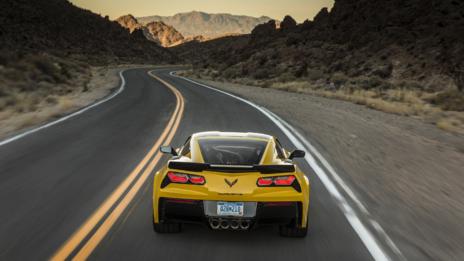
When I was 10, I believed that all Corvettes were just like the new Chevrolet Corvette Z06. They weren’t.That year, 1980, the 305 California was the newsmaker among Corvettes – and not in a good way. Created by General Motors as a way to continue selling its sports car in California as the state tightened its emissions rules, this model featured between its fibreglass fenders a wheezing 180-horsepower 5-litre V8 engine from the Biscayne sedan and a three-speed automatic transmission.Not that Californians had much to envy: the 350-cubic-inch engine found in Corvettes sold in the other 49 states churned out all of 190hp. Tthe Corvette was America’s only sports car, and that year, it was an embarrassment.
Being 10, I nevertheless wanted one rather badly – because, being 10, I hadn’t driven one, or anything else. It looked fast – unspeakably, illegally fast – and that was all that mattered. The trim and tidy Porsche 911, with which the Chevrolet has been compared countless times over the years, looked too sensible to be naughty. But the Corvette – particularly designer Larry Shinoda’s third-generation car – looked like a natural-born killer. I had seen Mark Hamill’s 1978 Star Wars follow-up, Corvette Summer, and loved it beyond common sense. It was a plain, unsubstantiated fact to me that nothing was faster than a C3 Corvette – never had been, never would be.

Mark Hamill's Stingray does its thing in the 1978 film, Corvette Summer (Credit: Warner Bros Entertainment)
I was wrong, of course. The Corvettes of my youth, including Mark Hamill’s red menace, were lame: creaky old chuffers with metal-flake paint jobs and mom-sedan mechanical bits. Without having driven either car, I would venture that the engine-donor 1980 Biscayne sedan, with whitewalls and button-tufted velour seats, was quicker off the line than the 1980 Corvette. And I’m probably right.
The 2015 Corvette Z06 is not lame. It is a monster, a barbarous mythical creature like those boulder-throwing Laestrygonians from Homer’s Odyssey. It is everything – every last inch – the Corvette I thought all Corvettes were when I was 10.
Before my stint with the Z06, I enjoyed back-to-back weeks in a Chevrolet Camaro SS with the 1LE performance package and a standard Corvette Stingray. To my surprise, I liked the Camaro more, so much so that I spent my entire week with the Stingray missing the 1LE. Why? The standard Corvette is certainly not a bad car. But with the 1LE package, the Camaro is, if you will indulge me once more, the Camaro I thought all Camaros were when I was a kid. It is raucous, cartoonish and angry. It is one of those cars that has strange effects on the driver – a swagger, for instance. I don’t normally have a swagger, but I swear the 1LE gave me one. My voice dropped by a good octave that week. Very odd. I called these physiological changes “Camannerisms”. They went away when I took delivery of the Corvette.
Even in blazing Torch Red, my manual-transmission-equipped Stingray test car felt, dare I say, a touch too civilised for its own good. It had perforated Napa leather seats and a 3D navigation system and an onboard wi-fi hotspot. It was very fast, certainly quicker and more agile than the 1LE Camaro, but it didn’t necessarily seem faster. And because I live in Los Angeles, a part of the world where appearances can matter more than reality, and where traffic citations are handed out like Halloween candy, seeming fast is more important that being fast.
The Z06 is different. For starters, it wields a 190hp advantage over the standard Stingray – as much as the 49-state 1980 Corvette produced in total. But unlike, say, the Dodge Challenger Hellcat, there is more to the Z06’s appeal than extra power. I have driven a good many fast cars over the years. There were exactly three that truly intimidated me: a 1999 Dodge Viper ACR with a huge wing, a 1981 Lamborghini Countach LP400S with six carburettors and this Corvette Z06. (OK, four if you count the terrifying, three-wheeled Campagna T-Rex, but let’s not.) Among those cars, the Z06 was both the most deserving of my fear, and the least. It was the fastest and most powerful by some margin, but also the most balanced and benign.
In reviewing the Z06 for BBC Autos, Dan Carney referred to the car as a “track-optimised variant of the seventh-generation Corvette.” It is a tidy descriptor for a superhero among supercars, and while not inaccurate, it does not capture the screaming outrageousness of Chevrolet’s achievement. I appreciate the technical challenges of building a truly quick track car, but building a great track car that is also a great road car – a car that is totally drivable on public roads yet somehow still feels comically inappropriate in such a setting – is some sort of black art. A great track car lapping a racetrack is expected; a great track car parading down Santa Monica Boulevard, its nasty, blatty bark setting off the alarms of parked cars along the way, is madness of the very best sort.
In hindsight, as much as I wanted to drive when I was 10, I am glad I couldn’t. And I am awfully glad that Chevrolet waited until I was old enough to build the Corvette of my dreams.
